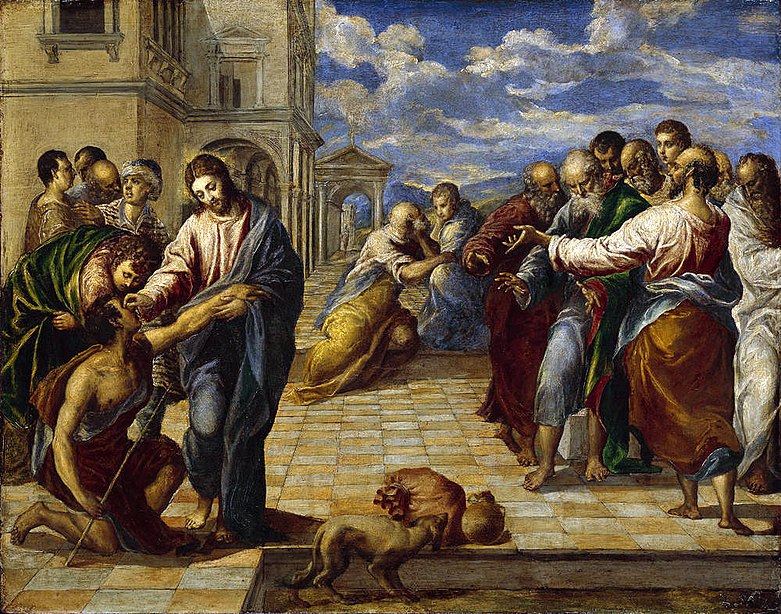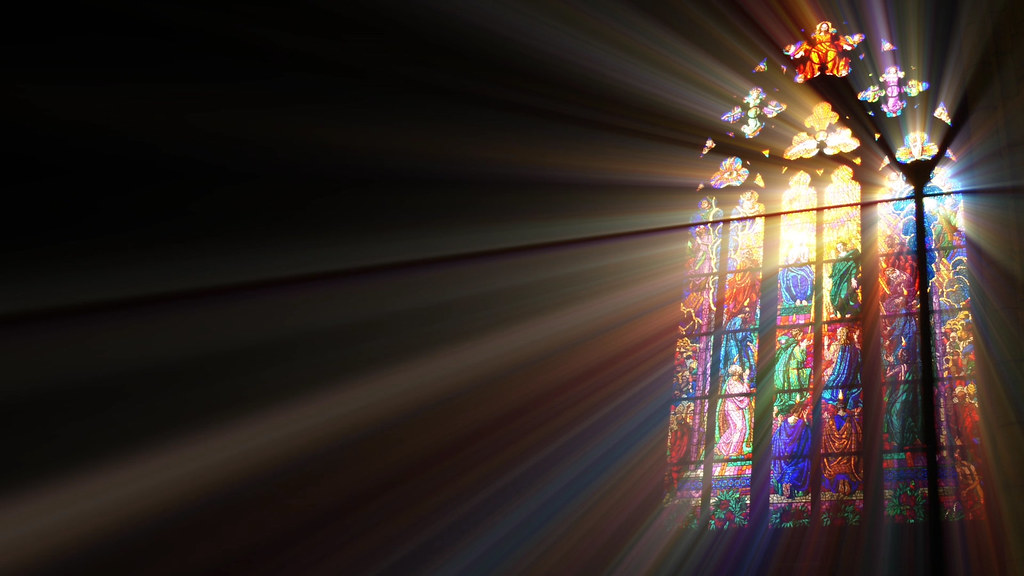John 9
 |
| Christ Healing the Blind, El Greco 1567 PD |
What are you; BLIND!?
This is a question that has been adopted as a phrase to voice our discontent with behaviors and actions we don’t really approve of.
As a parent when I ask my children to clean up, I seem to find myself asking this question flippantly,
Usually receiving the response from my children which proves sarcasm should not be wasted on the young;
“Why no, Daddy, I can see just fine!”
I also find myself asking this question as I drive from place to place, observing drivers that are either incapable of driving courteously or sometimes incapable of driving at all.
Interestingly, I find myself asking and even making accusations of blindness more often during this particular month every year or so.
During March Madness, whenever the West Virginia Mountaineers make it far enough into the NCAA Tournament, I find myself becoming a basketball fan.
Basketball, a sport which has rules that I honestly know about as well as the rules for cheese rolling or cricket.
Yet, if WVU ends up in the Sweet 16, I seem to find myself becoming the foremost authority on the game, which I have not only never played but avoided for fear of looking like a fool.
But there I am, sitting on the couch accusing the officials of blindness and demanding that the officials give my Mountaineers a free kick, an additional 15 yards for roughing the passer, or just outright appalled that the ball was called foul despite the fact that it was clearly not over the line.
In spite of how all this sounds to you, I honestly have no idea how to play basketball, I just want to root for my Mountaineers.
Yet, as incompetent as I am when it comes to basketball, I seem to make pejorative claims of others ability to see.
Thinking that I know so much more than I really do, that I can see so much clearer than anyone else.
Sitting on my couch in my own home, I can’t help but wonder, who do I think I am fooling?
No one, just myself….
~
Our gospel for today addresses blindness.
It also addresses sight but not just sight.
 |
| Healing of the Blind Man, Carl Heinrich Bloch 1834-1890 PD |
It addresses intuition, a word rooted in Latin that really means to look into, or inside of something.
It is more than just seeing that is being addressed in our gospel today. It is a deeper perception of something below the surface of what is before us.
It is also a LONG gospel reading.
Forty one verses to be exact, with only two verses (7&8) describing the miracle itself.
Yet we find ourselves doing what we always do, focusing on the miracle and losing sight of the surrounding story.
A story that contains thirty five verses that reveal the beauty of the slow process of this man’s sight being FULLY restored.
Thirty nine versus that also illustrate the degrees of blindness in others, as well as ourselves.
There is a progression to the restoration of the beggar’s sight because Jesus comes to the beggar faceless at the time of their meeting, because the beggar is still blind.
He does not know the face of the one who performs the miracle, only the name; Jesus.
So, when he is brought to the Pharisees by his neighbors in order to discover the source of this miracle, perhaps even the validity of it, he has very little to go on.
Questioned first by his neighbors as to the identity of the man who has healed him, he simply refers to Jesus as “a man called Jesus.”
In the midst of his interrogation at the hands of the Pharisees though, he seems to have looked deeper into what has transpired, looking deeper into just who Jesus is.
The beggar, upon being asked what he himself has to say about this man, further reflects on just what has happened, and it dawns on him that this must be the work of God.
Ironically, this realization seems to have come to him as much from the skeptical questioning of the Pharisees as it has from his own heart.
He is an honest man, responding to the questions with not only integrity but with his own sense of curiosity.
A desire to know just what has transpired for himself.
And when he returns to the Pharisees, his certainty of Jesus’ work as the work of God is affirmed.
Not by his own deep questioning, but by receiving more of the skeptical and even militant questioning of others.
Standing by his claim to the point of scorn and mockery, even being driven out of this Pharisaic court for no other reason than the persistence of his belief.
Ridiculed because he was willing to process the evidence of what has been shown clearly to him, not by Jesus, but by his inquisitors.
Evidence that he is willing to truly see, even as others turn away.
Because, others have learned to close their eyes to what they choose not to see.
Perhaps, because they have seen too much?
And maybe that has made them blind?
~
Another image that is found in this passage is one we have heard several times since Christmas.
It is a persistent theme in John’s Gospel; Jesus as the light of the world.
In all honesty, given the frequency with which we have talked about this theme I wasn’t certain it was important to address this week.
At least not until I considered the role light plays regarding our sight.
Photo by Nelly Volkovich, Picture provided through Unsplash
Science is not my strong suit, but you don’t have to be a scientist to appreciate the incredible nature of the human eye.
Not only because of what the human eye can do, but what we have done with the human eye.
Human beings are the only creatures on earth that are as capable of seeing as far beyond of what they can comprehend as we are.
We are also the only creatures that can see as deeply into the things around us as we can, even our own bodies.
We can see beyond our own planet, even the galaxy, in which we live.
We can see our own cells, viruses, even atoms!
And yet the more we see, the more curious we are and the more we want to see.
And the key to all this is LIGHT.
They say that eyes are the windows to the world.
And that is more true than we sometimes realize.
Because the lenses on our eyes allow the light that is reflected off the world to enter into the eye and our pupils control the amount of light that enters into the eye, controlling our focus.
The light that is reflected from our surroundings is projected onto our retina and that is what allows us to see the world.
It is in this same way that Jesus Christ reflects the Incomprehensible into our world, into our lives.
God, which is so far beyond what we can grasp is reflected into our lives by Christ.
But only if we are willing to open our eyes to that light, because if we shut our eyes tightly in spite of that light or to the world around us;
We might as well be blind.
~
This story offers a deep contrast to the unveiling of the beggar’s own sight.
There are three other groups that seem to be struggling with sight through most of the scenes in this story where Jesus and his disciples are mostly absent.
The crowd who cannot believe what they are seeing.
Seeking excuses and reasons that deny what is clearly standing before them.
Perhaps having seen so much of the reality of the world around them, that they refuse to believe such a good thing as this could occur to such a man.
Denying his very identity, even accusing him of being a stand in or lookalike.
Perhaps jaded by what they have seen in the world.
So pessimistic that they have come to refuse that God can be at work in so low of a place as the eyes of a blind beggar.
Refusing to reconcile a God that can be at work for good in all things, even those things the world seems to have lost interest in or has no time for, like the poor.
Then there are the parents of the beggar who do not deny their son.
They admit that it is their child and that he has come to find his sight, but they turn their own blind eye to the situation.
Turning a blind eye to the questions of not only others but their own questions.
They must know that such questions will not go away and yet they refuse to even entertain the most basic question; how such a thing as this has occurred?
 |
| Healing of the Blind Man, Duccio 1308-1311 (PD) |
Certainly not avoiding the question because it has not arisen in their own minds, but because they fear the answer.
An answer that will cast them out of the synagogue, out of their social circles, out of the worldly graces of their own society.
Far too risky of a question to ask if it can be avoided.
So they choose to deny the very reality of what has happened, retreating to a position of blindness.
And then we have a group of Pharisees who have organized themselves into a kangaroo court.
They have made their judgment before the beggar even arrives in their court on his first visit.
Then on his second and final visit even dictating TO the beggar what has “officially” transpired during his healing.
Sharing the good news with the beggar that he HAS been healed by God and should give glory to God but advising that such a judgment by the court will include the accusation of Jesus as a sinner.
The court doesn’t offer a judgement to the beggar, they offer two options:
Confess that Jesus is a sinner and a fraud
Or
Oppose the court’s judgment and be accused and cast out himself as a sinner.
And so;
the beggar is driven out.
~
So, where do we find ourselves in this story?
I would say that a healthy dose of skepticism in the midst of our faith is merely a reflection of authenticity and honesty.
The same authenticity and honesty that leads the beggar to find himself slowly confessing his faith to Jesus when he gazes upon Christ’s face for the first time.
A faith that is tested by honest and thorough questioning.
But that is a fine line to walk, isn’t it?
Because if we see too much of the world, we find ourselves blinded by how broken it all is.
Refusing to believe in anything.
This is a far cry from healthy skepticism, it is unbelief and it leads to hopelessness and despair.
So, we could always protect ourselves with naivety and an overabundance of optimism.
Now this, this is what we love as the church.
Rose colored glasses and care bears sliding down rainbows.
But is that the reality of the world outside the walls of the church?
A world where only sinners are tried by the afflictions of the world and we chosen few are protected by God’s merciful hand as compensation for our regular attendance and generous donations?
Sisters and brothers, I am CERTAIN there are a few of you out there who cannot accept this to be true, I know I can’t.
The fact is that we see what we WANT too see of the world.
And this leads us into either a blindness of unbelief or the invisibility of irrelevance.
We are called to be a church that is faithful to the promise that is true AND relevant in a world that needs that assurance now more than ever!
And if we board up the windows of our sanctuary, it may deny the ugliness of the world outside, but it will also deny the light of that same world that shines so brilliantly through, bringing us the hope that WE so crave!
 |
| www.stockphotosforfree.com/ |
We are all blind to certain realities.
So jaded, we refuse to see the beauty of the world.
So naive, we refuse to see the ugliness of the world.
So superstitious, we refuse to question.
So pessimistic, we refuse to believe.
But for us to truly see we must not only see the world but see into the world, embracing a promise from the Kingdom of God that exists also in the broken Kingdom of man.
Because true sight is the wholeness of seeing two kingdoms.
This leads to seeing it all together and when it is all brought together, the wholeness of the world can lead us to seeing the holiness of God,
And that is not only a faith that is tested but a faith that is authentic, honest, and rooted in the cross of Christ +.
~
This past week there was a lot going on.
In the midst of a busy week, my wife and I received a number of messages on Tuesday morning, concerning some close family friends, one of which was far more than just a mentor to me.
We came to discover that their daughter had died after a struggle with addiction.
Addiction to a drug that I regularly encountered as a police officer, a drug that became my worst fear after encountering both the substance and its victims.
And when I heard the news my heart sank into the pit of my stomach.
I’ve struggled to think clearly this week because I found myself asking how?
How for so many years did I not see?
Even as I was executing search warrants, dealing with others who were addicted to that substance?
How was I so blind as I interacted with their daughter almost weekly?!
If only I had seen, I could have done something, maybe I could have supported them more than I did.
But I didn’t see, even now, looking back, I cannot see it.
As a police officer, we used to talk about the bubble that the rest of our communities live in, isolating themselves from the world in a state of ignorant bliss.
It didn't take long after my resignation from the department to find myself comfortable in that bubble, even admitting to old friends that I now willingly ignored what I knew was going on in the neighborhoods that were just a block from the seminary where I was studying.
Now, I am not sharing this story to gain your sympathy, but I need you to hear that no matter how much we see or how much we think we know, we all turn a blind eye to what we don't want to see. We all have a tendency to see what we WANT to see and perhaps this Pharisee has chosen blindness too long, because Christ’s light needs to be seen in those dark places that we turn a blind eye to, and in our baptisms we are called to be the candles that carry that light into those places.
Now, I am not sharing this story to gain your sympathy, but I need you to hear that no matter how much we see or how much we think we know, we all turn a blind eye to what we don't want to see. We all have a tendency to see what we WANT to see and perhaps this Pharisee has chosen blindness too long, because Christ’s light needs to be seen in those dark places that we turn a blind eye to, and in our baptisms we are called to be the candles that carry that light into those places.
Amen.
 |
| Free Commercial Use from Pixabay (No attribution found or required) |






